You are using an out of date browser. It may not display this or other websites correctly.
You should upgrade or use an alternative browser.
You should upgrade or use an alternative browser.
Should i keep this 'very Strong' Fluorescence diamond? w/PIC
- Thread starter connect123
- Start date
Imdanny
Ideal_Rock
- Joined
- Jan 21, 2008
- Messages
- 6,186
LynzeeLeigh
Rough_Rock
- Joined
- Feb 5, 2011
- Messages
- 45
Re: Should i keep this 'very Strong' Fluorescence diamond? w
I think you two should stop thinking about what diamonds "should" look like and think about what YOU want. Personally, I find the stone with the strong fluorescence more beautiful than the other one. Granted, I'm not seeing them in person, but it really is about what you find more beautiful, not what the norm is.
I think you two should stop thinking about what diamonds "should" look like and think about what YOU want. Personally, I find the stone with the strong fluorescence more beautiful than the other one. Granted, I'm not seeing them in person, but it really is about what you find more beautiful, not what the norm is.
- Joined
- Jan 11, 2006
- Messages
- 58,576
Re: Should i keep this 'very Strong' Fluorescence diamond? w
Wow is all I can say! The G looks whiter and brighter than the F in almost every picture! It certainly is not milky! I would LOVE to have that diamond! If anyone has put doubt in your mind about fluorescence being bad, just get rid of that thought because there is unfair prejudice in some jewelers against fluorescence. One of these days someone is going to be smart and price them higher because of their unusual natural beauty! Those who buy now are the smart ones, as far as I am concerned!
The G looks whiter and brighter than the F in almost every picture! It certainly is not milky! I would LOVE to have that diamond! If anyone has put doubt in your mind about fluorescence being bad, just get rid of that thought because there is unfair prejudice in some jewelers against fluorescence. One of these days someone is going to be smart and price them higher because of their unusual natural beauty! Those who buy now are the smart ones, as far as I am concerned!
BUT, just use your eyes and decide if what you see is beautiful to YOU! I think it is beautiful, but I am unfortunately not the one who will be wearing it!
ETA: uh-oh...this is a very old thread! Wonder what they decided???
Wow is all I can say!
BUT, just use your eyes and decide if what you see is beautiful to YOU! I think it is beautiful, but I am unfortunately not the one who will be wearing it!
ETA: uh-oh...this is a very old thread! Wonder what they decided???
luckky
Shiny_Rock
- Joined
- Feb 20, 2011
- Messages
- 198
Re: Should i keep this 'very Strong' Fluorescence diamond? w
 May I guess?? 1.5 ct and 2 ct right Wow...they are pretty I couldn't turn down anyone of time...
May I guess?? 1.5 ct and 2 ct right Wow...they are pretty I couldn't turn down anyone of time...  pick both one for E ring and one for pendant
pick both one for E ring and one for pendant 
redyns|1281335501|2673862 said:Just curious . . . how big are those diamonds?
Sheherizaad
Shiny_Rock
- Joined
- Feb 7, 2011
- Messages
- 244
Re: Should i keep this 'very Strong' Fluorescence diamond? w
I was in a similar as you guys. I had to choose between an I, VS2 VG/G 2.34 with Very Strong Blue Flour and an I, VS2, Ex/VG 2.14 with No Flour. I chose the first.
Sometimes it's very strong, and sometimes it's ICY white. When I took it to an independant appraiser he initially thought it was a G color with VSBF. Granted, maybe my stone is an exception and it threw him for a loop, but he'd been doing this for more than 20 years so I'm more inclined to agree that in HIGHER colors, VSBF (that is not milky or hazy) is a plus, not a negative.
Here are some pictures of my stone in various lighting. This particular set of shots is in the same exact lighting except that my hand SHIFTED ever so slightly. One pic clearly has DEFINITIVE flour and the other one has none...
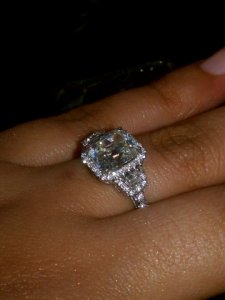
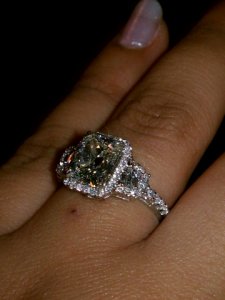
I was in a similar as you guys. I had to choose between an I, VS2 VG/G 2.34 with Very Strong Blue Flour and an I, VS2, Ex/VG 2.14 with No Flour. I chose the first.
Sometimes it's very strong, and sometimes it's ICY white. When I took it to an independant appraiser he initially thought it was a G color with VSBF. Granted, maybe my stone is an exception and it threw him for a loop, but he'd been doing this for more than 20 years so I'm more inclined to agree that in HIGHER colors, VSBF (that is not milky or hazy) is a plus, not a negative.
Here are some pictures of my stone in various lighting. This particular set of shots is in the same exact lighting except that my hand SHIFTED ever so slightly. One pic clearly has DEFINITIVE flour and the other one has none...


Sheherizaad
Shiny_Rock
- Joined
- Feb 7, 2011
- Messages
- 244
iota15
Brilliant_Rock
- Joined
- Mar 19, 2010
- Messages
- 1,278
- Joined
- Jan 19, 2018
- Messages
- 235
The bad reputation for any Fluorescence is due to the fact that very few of the Very strong ones are hazy and looks bluish.
Put it next to a diamond with no Fluorescence and see if it looks hazy/whitish/cloudy.
To me it looks hazy.
When it is hazy it loses a lot of its brilliance.
In any case I will not take a Very Strong one.
Please read what GIA write about Fluorescence in a small leaflet they inserted in the Certificates envelopes
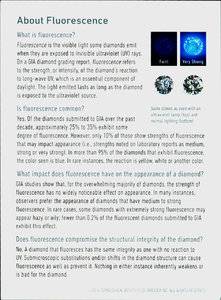
From: http://4cs.gia.edu/en-us/blog/understanding-diamond-fluorescence/
Have you ever noticed the term “Fluorescence” on a GIA Diamond Grading Report? Did you know that some, but not all, diamonds show effects under ultraviolet light?
For most people who purchase diamonds, fluorescence will be a non-issue, but some might be confused by the term. Below are commonly asked questions, and helpful answers from GIA researchers who have studied fluorescence in depth.
What is diamond fluorescence?
Diamond fluorescence, in its most simple form, is the effect that ultraviolet (UV) light has on a diamond. When you stand under a blue light or ultraviolet light, sometimes you can see your whites get brighter or your teeth appear to glow. This is the same effect the diamond has under the UV rays. Fluorescence is the visible light that a diamond emits when it is exposed to the UV rays.
On a GIA Diamond Grading Report, fluorescence refers to the strength, or intensity, of the diamond’s reaction to long-wave UV, which is an essential component of daylight. The light emitted lasts as long as the diamond is exposed to the ultraviolet source.
Is fluorescence common?
Yes. Of the diamonds submitted to GIA over the past decade, approximately 25% to 35% exhibit some degree of fluorescence. However, only 10% of those show strengths of fluorescence that may affect appearance (i.e., strengths noted on laboratory reports as medium, strong, or very strong).
In more than 95% of the diamonds that exhibit fluorescence, the visible color is blue. As blue is the complementary color to yellow, the most common tinted color in diamonds, blue fluorescence can make yellowish diamonds look white or colorless. In rare instances, the reaction to fluorescence is yellow, white or another color.
What impact does fluorescence have on the appearance of a diamond?
GIA studies show that for the overwhelming majority of diamonds, the strength of fluorescence has no widely noticeable effect on appearance. In the GIA Fluorescence Study, it was found that the average person could not make a distinction between a diamond withfluorescence and a diamond without.
In many instances, observers prefer the appearance of diamonds that have medium to strong fluorescence. In rare cases, some diamonds with extremely strong fluorescence may appear hazy or oily; fewer than 0.2% of the fluorescent diamonds submitted to GIA exhibit this effect
Does fluorescence compromise the structural integrity of the diamond?
No. A diamond that fluoresces has the same integrity as one with no reaction to UV. Submicroscopic substitutions and/or shifts in the diamond structure can cause fluorescence or can prevent it. Nothing in either instance inherently weakens or is bad for the diamond.
Should I buy a diamond that exhibits fluorescence?
The preference to buy a diamond that exhibits fluorescence is a personal one, as a diamond’s appearance must be taken as a whole. Other factors can influence color appearance more strongly than fluorescence, such as how the diamond has been cut, whether the diamond is viewed in natural or artificial light, and even what you’re wearing on any given day.
Put it next to a diamond with no Fluorescence and see if it looks hazy/whitish/cloudy.
To me it looks hazy.
When it is hazy it loses a lot of its brilliance.
In any case I will not take a Very Strong one.
Please read what GIA write about Fluorescence in a small leaflet they inserted in the Certificates envelopes

From: http://4cs.gia.edu/en-us/blog/understanding-diamond-fluorescence/
Have you ever noticed the term “Fluorescence” on a GIA Diamond Grading Report? Did you know that some, but not all, diamonds show effects under ultraviolet light?
For most people who purchase diamonds, fluorescence will be a non-issue, but some might be confused by the term. Below are commonly asked questions, and helpful answers from GIA researchers who have studied fluorescence in depth.
What is diamond fluorescence?
Diamond fluorescence, in its most simple form, is the effect that ultraviolet (UV) light has on a diamond. When you stand under a blue light or ultraviolet light, sometimes you can see your whites get brighter or your teeth appear to glow. This is the same effect the diamond has under the UV rays. Fluorescence is the visible light that a diamond emits when it is exposed to the UV rays.
On a GIA Diamond Grading Report, fluorescence refers to the strength, or intensity, of the diamond’s reaction to long-wave UV, which is an essential component of daylight. The light emitted lasts as long as the diamond is exposed to the ultraviolet source.
Is fluorescence common?
Yes. Of the diamonds submitted to GIA over the past decade, approximately 25% to 35% exhibit some degree of fluorescence. However, only 10% of those show strengths of fluorescence that may affect appearance (i.e., strengths noted on laboratory reports as medium, strong, or very strong).
In more than 95% of the diamonds that exhibit fluorescence, the visible color is blue. As blue is the complementary color to yellow, the most common tinted color in diamonds, blue fluorescence can make yellowish diamonds look white or colorless. In rare instances, the reaction to fluorescence is yellow, white or another color.
What impact does fluorescence have on the appearance of a diamond?
GIA studies show that for the overwhelming majority of diamonds, the strength of fluorescence has no widely noticeable effect on appearance. In the GIA Fluorescence Study, it was found that the average person could not make a distinction between a diamond withfluorescence and a diamond without.
In many instances, observers prefer the appearance of diamonds that have medium to strong fluorescence. In rare cases, some diamonds with extremely strong fluorescence may appear hazy or oily; fewer than 0.2% of the fluorescent diamonds submitted to GIA exhibit this effect
Does fluorescence compromise the structural integrity of the diamond?
No. A diamond that fluoresces has the same integrity as one with no reaction to UV. Submicroscopic substitutions and/or shifts in the diamond structure can cause fluorescence or can prevent it. Nothing in either instance inherently weakens or is bad for the diamond.
Should I buy a diamond that exhibits fluorescence?
The preference to buy a diamond that exhibits fluorescence is a personal one, as a diamond’s appearance must be taken as a whole. Other factors can influence color appearance more strongly than fluorescence, such as how the diamond has been cut, whether the diamond is viewed in natural or artificial light, and even what you’re wearing on any given day.
Attachments
- Joined
- Aug 14, 2009
- Messages
- 27,485
Time marches on!!!Thread is seven years old folks
But it still makes me want to buy a new stone lol
Share:
Past, Present, Future: The Meaning of Three-Stone Engagement Rings Past, Present, Future: The Meaning of Three-Stone Engagement Rings - 04/14
Past, Present, Future: The Meaning of Three-Stone Engagement Rings - 04/14


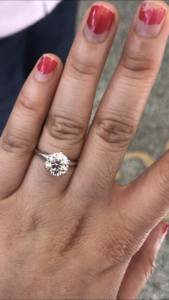
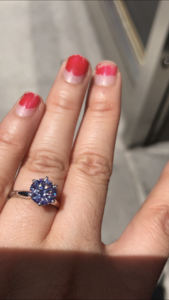
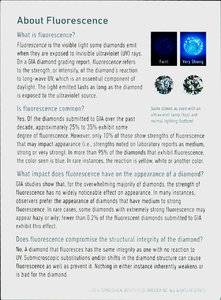

300x240.png)